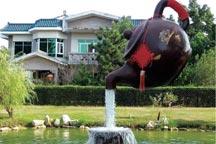2. Industrial Development and Structural Change
(1) Primary Industry and Its Profitability
In 2008, the added value of Tibet's primary industry reached 6.051 billion yuan, making up 15.3 percent of the region's GDP. In the same year Tibet had a sown area of 170,200 ha for grain, and produced 950,000 tons of grain, exceeding 900,000 tons for the tenth year in a row. The grain output for each ha of farmland amounted to 5,581 kg, 3.1 times more than the 1,370 kg/ha in 1959. Data analyses [7] indicate that in 2008 Tibet had a grain output of 333 kg per capita, each person possessing nearly one kg per day, while before Tibet's democratic reform in 1959 its annual grain output was only 150 kg per capita and grain possession per capita was less than half a kg per day. These changes are shown in Fig. 4.
In 2008, Tibet had 24 million head of livestock, an increase of1.5 times over the 1959 figure of less than 10 million. In addition, the commercialization rate of Tibet's animal husbandry has markedly improved. A survey shows that before the democratic reform in 1959 the proportion of major kinds of livestock delivered to the slaughterhouse in Tibet was less than 10 percent. In 2008, the proportion of cattle, pigs and sheep delivered for sale was 19.8 percent, 57.2 percent and 30.8 percent respectively. In 2008, the output value of Tibet's livestock breeding amounted to 3.896 billion yuan, 5.1 times more than that in 1959. In 2008, Tibet's meat output was 242,700 tons, and the milk output 295,200 tons, an increase of more than two times the figures before the democratic reform in 1959. This data is shown in Fig. 5.
Modernization of agricultural production has been the major reason for the growing output of agricultural products. Before the democratic reform in Tibet in 1959, wooden plows were used for agricultural production, and yaks were used for threshing in rural areas. In some areas the slash-and-burn method of farming was still common. Since 1959, Tibet has made extensive efforts to carry out farmland capital construction and spread scientific ways of farming by building irrigation projects, improving soil and farming modes, promoting the use of new types of agricultural tools, and cultivating excellent seed varieties. Since 1990, comprehensive agricultural development projects and a series of infrastructure projects related to agriculture and animal husbandry have been carried out in the middle valleys of the "one river and its two tributaries"- the Yarlung Zangbo River, and the Lhasa and Nyangqu rivers.
In recent years, the central government and the local government of Tibet have regarded agriculture as the basis of the national economy, and a key industry, focusing government work on problems facing agriculture, rural areas and farmers, and increasing financial investment in the primary industry[8] by providing huge subsidies for things necessary for agricultural production such as excellent seeds, chemical fertilizers, agricultural machinery and diesel oil. The subsidies enable farmers in Tibet to purchase their materials for agricultural production at prices 30 to 50 percent lower on average than those in other areas of China. These measures for assisting agriculture have reduced farmers' burdens and spurred agricultural development. The supply of modern equipment related to agriculture and animal husbandry has been raised to a completely new level. In2008, the total power of machinery for agriculture and animal husbandry reached 3.4 million kw, including 13,184 large and medium-sized agricultural tractors, 90,500 small and walking tractors, 2,684 combines, 22,605 threshing machines and 17,196 agricultural transport vehicles. Tibet's farming has basically achieved a transformation from "two oxen pulling a plow"[9] to modern farming, thus greatly improving the comprehensive agricultural production capabilities, the output rate of land, and labor productivity.




















